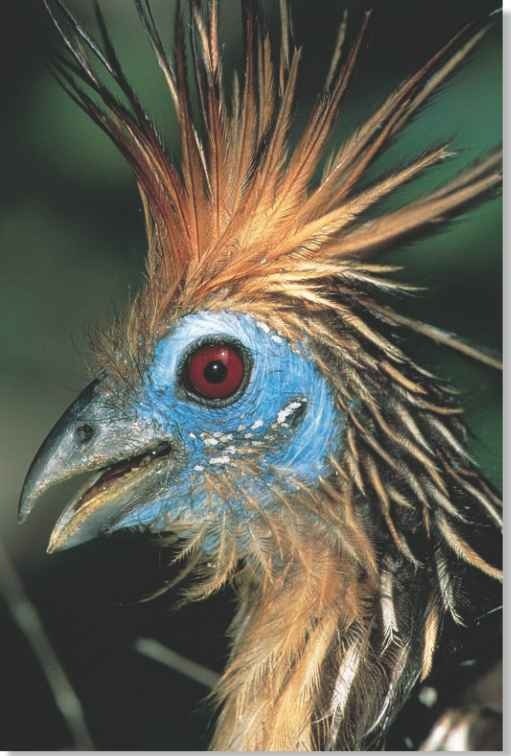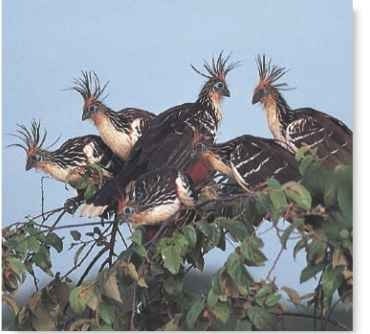ORDER
Cuculiformes
FAMILY
Opisthocomidae
GENUS & SPECIES
KEY FEATURES
• Unique bird of South American river and marsh edge
• Chicks have claws on their wings, letting them scramble among the tree branches
• Adapted to digest the tough, rubbery vegetation by swamps and rivers of the Amazon and Orinoco
• Flies in short bursts of 100′ or so
WHERE IN THE WORLD?
Found in northeastern South America, particularly in the rainforests formed by the Amazon and Orinoco rivers; forested borders of streams provide leafy food and nesting sites
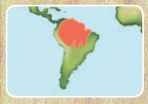
Lifecycle
The colorful hoatzin has evolved a variety of highly unusual features that suit it to life in the permanently lush and leafy wetlands of South America.
HABITAT
The hoatzin is found over a large part of South America, from Guyana and Brazil west to Ecuador and Bolivia. This region is characterized by permanently flooded forests along the overgrown banks of the Amazon, Orinoco and other river systems.
Two factors affect the hoatzin’s range: anatomy and diet. With weak wings, the hoatzin is better at scrambling along branches than flying. This, coupled with the chick’s ability to swim, suits the hoatzin to a landscape where a mass of tree limbs hangs over water Tough, tropical marshland vegetation, such as arum and the white mangrove, provides essential ingredients in its diet.
Birds of a feather The hoatzin lives in a small group or colony.
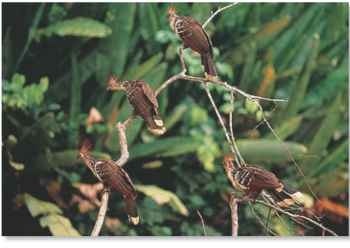
CONSERVATION
The greatest threat to the hoatzin is that of the Amazon region in general. Widespread clearing of forests has reduced the hoatzin’s range, depriving local populations of their habitat. Captive-breeding programs are unlikely to restore populations because the hoatzin’s restricted diet makes it difficult to rear outside its natural habitat. Hoatzins rarely survive more than a year in captivity.
BEHAVIOR
A DANGEROUS OUTING
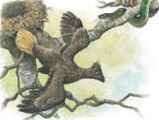
1 Explore…
Using the claws on its wings as “hands” to grasp vegetation, an adventurous young hoatzin sets out from its nest.
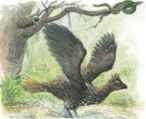
Escape…
The hoatzin spots a deadly palm viper coiled on branch. The young hoatzin simply drops from the tree into the water below…
BREEDING
Hoatzins breed through the year; breeding increases just before the rainy season and occurs in groups of 2-6 birds. Both parents build the thin platform of a nest in branches over the water
Parents take turns sitting on the eggs. Newly hatched young are almost naked but soon grow a downy plumage. They stay in the nest for about 14 days, then start exploring, using their curious ability to swim. As the chick grows, it loses its wing claws, learns to fly and loses the ability to swim. It continues to use its spread wings for balance as it scrambles about, often losing a few feathers in the process.
The hoatzin is most active in morning and evening. It spends the hottest part of the day in dense foliage on a branch over the water which provides a vital escape route if predators pass by.
A poor flier, the hoatzin prefers to climb to the tops of low trees. With such a vantage point, the hoatzin can look out for danger or promising feeding areas. Occasionally, the hoatzin flies, gliding between small creeks or bays, to a new perch, where it slumps down with its callused rump resting on the branch.
Hoatzins live in a colony of 10 to 20 members. Cooperative parents accompany young on their first awkward scrambles and spread their wings to screen a chick from predators.
The hoatzin’s name is an Indian word, mimicking the bird’s call. Other local names include catinguero, meaning “musk-smelling,” and cigana, meaning “gypsy,” which refers to the colorful plumage.
Hoatzin fossils dating back 50 million years to the Oligocene Epoch have been uncovered in South America, establishing the ancient origins of this unusual bird.
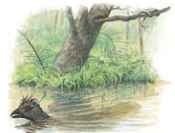
Swim…
…and puts distance between itself and the palm viper by swimming off in the sluggish water. It uses both wings and feet to swim.
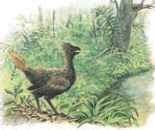
Return
The hoatzin watches the snake and looks for other threats. When the coast is clear, the bird clambers back to safety.
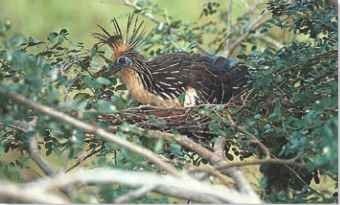
Brood on the branch
Two or three eggs are laid in an untidy stick nest.
FOOD & FEEDING
The hoatzin feeds mainly on arum and mangrove foliage. It picks at leaves with its beak, forms the pieces into a ball in its mouth and swallows the food in large chunks.
The leaves that make up the hoatzin’s diet are rubbery and tough, and few birds can digest them. The hoatzin’s crop, a storage cavity in the chest, is so powerfully muscled that leaves are broken down with ease. The crop is also divided into sections: both these factors help with digestion. Swallowed balls of leaves are ground into a fine mash in the crop before passing through the gizzard and small intestine to be digested.

A Easy meal
Leafy food is close at hand in the lush forests.

PROFILE
Hoatzin
The ungainly hoatzin does not need to fly far in search of food. In fact, its wings are more useful as stabilizers than for flight.
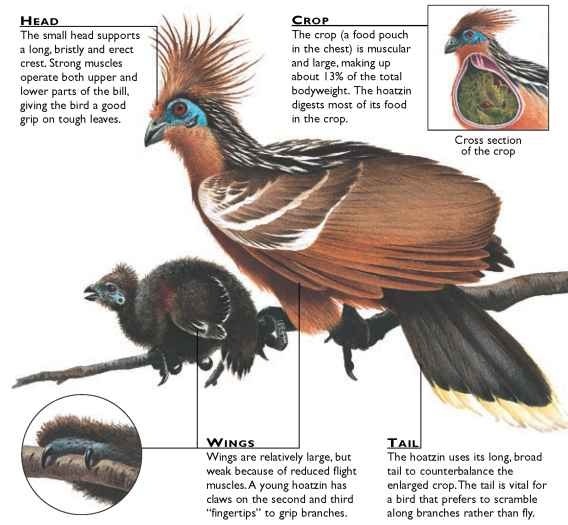
CREATURE COMPARISONS
Many features of the hoatzin, such as muscle attachments, skeletal structure and the chick’s wing claws, resemble those of the archaeopteryx, an ancient bird that lived about 150 million years ago in the Jurassic period. Similarities such as these have helped to fuel debate about the evolution of flight in birds.
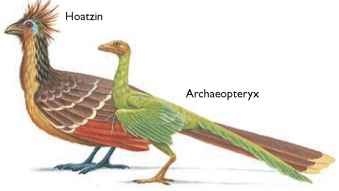
| VITAL STATISTICS | |
| Weight | 26-28 oz. |
| Length | 24.4″ |
| Sexual Maturity | 1-2 years |
| Mating season | Onset of rainy season (once or twice a year) |
| Number of Eggs | 2-5; usually 3 |
| Incubation period | 4 weeks |
| Birth ! Interval | 6 months . or 1 year - |
| Typical 1 Diet | Fruit and 1 eaves, particularly those of arum and mangrove |
| Lifespan | Unknown |
RELATED SPECIES
• Since 1837 the hoatzin has been linked to eight different bird orders, with birds such as pigeons, cranes, parrots and cuckoos. Placed in a family and a genus of its own, the hoatzin was then attached to the Galliformes (turkeys, pheasants, partridges and quails). The hoatzin now belongs to the order Cuculiformes, which includes coucals, cuckoos and roadrunners.
